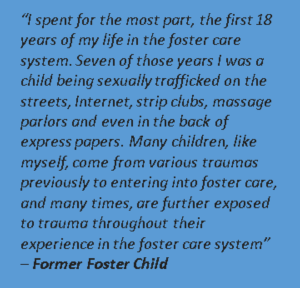 Did you know that January is Human Trafficking Awareness Month in the United States? If not, you may not know that researchers estimate that human trafficking is a global industry with revenues from $51 to $99 billion annually, up from $32 billion just a few years ago. In this case, more revenue is a bad thing and indicative of a problem that is worsening. After drug trafficking and counterfeiting, it is the world’s most profitable criminal activity.
Did you know that January is Human Trafficking Awareness Month in the United States? If not, you may not know that researchers estimate that human trafficking is a global industry with revenues from $51 to $99 billion annually, up from $32 billion just a few years ago. In this case, more revenue is a bad thing and indicative of a problem that is worsening. After drug trafficking and counterfeiting, it is the world’s most profitable criminal activity.
Did you know that human trafficking is affecting hundreds of thousands of children in the U.S. alone? This is often referred to as the Commercial Sexual Exploitation of Children (CSEC) and is defined as a commercial transaction that involves the sexual exploitation of a child, such as the prostitution of children and child pornography. CSEC may involve coercion and violence against children and amount to forced labor and a form slavery, as well as offering the sexual services of children for compensation, financial or otherwise. CSEC is alive and well in the United States and although there are pockets of innovation at the state and federal level on the law enforcement side of the problem, many are still having a very difficult time combatting this growing issue.
Did you know that in 2013, a federal report issued by the Administration of Children, Youth, and Families, showed that up to 90 percent of children and youth victims of child sex trafficking had been involved with child welfare services? This overlap is echoed in other national, state and local estimates. For instance:
- 60% of runaways who end up being trafficked into the sex trade had once been through social services or the foster care system.
- In San Diego, California between 80-95% of CSEC were known to the child welfare system.
- 60% of the child sex trafficking victims recovered in a nationwide FBI raid, in more than 70 cities, were children from foster care or group homes.
- In 2012, Connecticut reported 88 child victims of sex trafficking. Eighty-six were child welfare-involved, and most reported abuse while in foster care or residential placement.
A recent Governing article entitled, “Fighting Sex Trafficking Is Harder Than It Seems” states, “For now, most governments are in the nascent stages of recalibrating their approach -- if this issue is on their radar at all.” How do you win a fight if you are only reacting and defending? You don’t.
Fighting back begins with data
Those in child welfare understand that children who fall prey to human trafficking in the United States frequently have prior involvement with the child welfare system, through child protective service investigations or placement in foster care. And though there is data available to identify those at the highest risk of being targeted, almost no jurisdiction is using that data to prevent or intervene with those higher-risk young people.
A month into my job at SAS, during a meeting with a seasoned child welfare director in a large California county, he told me, “If I could predict anything, I would want to predict those youth who will become CSEC involved. That is what is keeping me awake at night.”
Well, I believe it can be done with data currently available to child welfare agencies. Did you know that between 70%-90% of exploited children have experienced child sexual abuse before they are first commercially exploited? Furthermore, children who experienced sexual abuse are 28 times more likely to be arrested for prostitution at some point in their lives than children who did not? In addition to sexual abuse history, other attributes of children at a higher risk of trafficking include:
- Signs of current physical abuse and/or sexually transmitted diseases
- Homelessness
- Witnessed domestic violence
- History of running away or current status as a runaway
- Inexplicable appearance of expensive gifts, clothing, cell phones, tattoos, or other costly items
- Multiple failed placements
- Presence of an older boyfriend or girlfriend
- Drug addiction
- Withdrawal or lack of interest in previous activities
- Gang involvement
Knowing that most of this data is available on youth in care in all states, couldn't we use that data, in conjunction with other factors, to identify high-risk kids and begin being proactive?

2 Comments
Very Sobering. There is such a marginal Federal and Respective State enforcement and oversight. I am certain that most respected treatment organizations have numerous personnel with Secondary Trauma. Needless to say; they aren't even the victims. Like throwing paper clips at the giant.
In Louisiana, DCFS is mandated to immediately report children missing from care to NCMEC and NCMEC in turn asks a series of questions (child sex trafficking protocol) designed to determine if the child is at risk for or suspected of being trafficked. All NCMEC Intake Reports are then sent to the Louisiana Clearinghouse for Missing & Exploited Children. In cases where it is determined the child is at risk or suspected or being trafficked, it is assigned to a Special Victims Unit field office for follow up. In addition, LACMEC maintains a database to monitor how many times a child is reported missing in order to further identify those children at high risk.